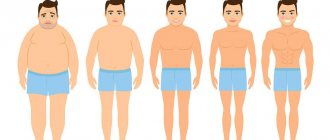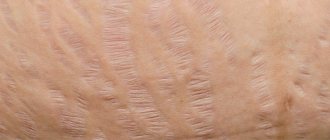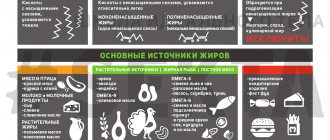There are many misconceptions and myths about fats, so it can be difficult to understand all the details of this topic on your own. We will tell you what fats are and what types they are, why we need them and what foods they are found in.
In the mid-20th century, the word “fats” began to be associated with health hazards.
Some versions associate the beginning of this period with the heart attack of US President Dwight Eisenhower. The case attracted public attention to the problem of cardiovascular diseases, and scientists came to the conclusion that saturated fats increase the level of bad cholesterol. In 1980, the US Department of Agriculture and the US Department of Health and Human Services released the Dietary Guidelines for Americans. The UK issued similar guidance in 1984. The main idea was to avoid excessive fat intake, especially saturated fat and cholesterol.
Since then, the scientific community has learned more about how fats affect the body. In different countries, recommendations for the amount of fat in the diet vary from 20 to 35% of daily calories. Rospotrebnadzor recommends consuming no more than 30% fat per day.
What are fats
For the human body to function normally, it needs macro- and micronutrients. Micronutrients are substances that are needed in small quantities, such as vitamins and minerals. And macronutrients are those that are needed in large quantities. There are only three of them: carbohydrates, proteins and fats.
What are probiotics and should you include them in your diet?
Macronutrients are sources of energy for the body. The body stores all unspent proteins, fats and carbohydrates from food as fats.
Fats are organic compounds that do not dissolve in water. Along with wax, cholesterol, and fat-soluble vitamins, they are part of the lipid group.
Subcutaneous fat
From the name it becomes clear that this is fat that is located directly under the skin. All the “folds” that can be found on the body are subcutaneous fat. From a medical point of view, this fat is completely harmless to the body and creates only a cosmetic problem. Essentially, this is the body's energy reserves. Such fat, unlike visceral fat, is much less mobile and more difficult to fight. In this case, only cardio exercise will not be enough and it is necessary to include a diet correction , which involves a significant reduction in fats and fast carbohydrates.
Types of fats
The structure and properties of fat molecules depend on the number of bonds of carbon atoms. This determines how quickly and easily the body metabolizes fats. Approximately 95% of fats in the human diet are triglycerides
Educational block : A triglyceride is a fat molecule that consists of glycerol and three fatty acids. When fats enter the body with food, they reach the small intestine almost unchanged. Once they are in the digestive system, the hormones send a signal to the liver, which sends bile salts to the small intestine. ⠀ This is one of the components of bile, which the body uses to break down fats, absorb fat-soluble vitamins and remove metabolic products from the body. Bile salts break down fats, and pancreatic enzymes break them down. Next, the cells of the intestinal walls absorb them and send them into the bloodstream using the lymphatic system.
Fatty acids are molecules in the form of chain links in which carbon atoms are linked to each other. Depending on the number of bonds between the units, fatty acids are divided into:
| Type of fat | Chemical structure | Condition at room temperature (+25C) |
| Saturated | No double or triple bonds | Solid |
| Monounsaturated | One double bond (Cis configuration) | Liquid |
| Polyunsaturated | Two or more double bonds (Cis configuration) | Liquid |
| Trans fats | Double Bond (Trans Configuration) | Solid |
Almost all foods containing fats combine all 4 types of fatty acids.
Saturated fats
Photo by Sorin Gheorghita / Unsplash
At room temperature, saturated fats remain solid. The main sources are animal products, dairy products, palm and coconut oils. Even chicken and nuts contain small amounts of saturated fat.
Foods high in saturated fat:
- Fatty meat and meat products: bacon, sausages, pork, lard
- Dairy products: cheese, butter, ice cream, cream
- Confectionery: sweets, cookies, pastries and cakes
- Palm and coconut oils
- Coconut cream
For many years, consuming this type of fat has been associated with an increased risk of cardiovascular disease and obesity, and nutritional recommendations have talked about the dangers of saturated fat. Some studies show little evidence for this idea.
Avoiding saturated fats can be harmful if your diet is filled with refined carbohydrates instead. But when replacing saturated fats with unsaturated ones, the level of bad cholesterol decreases, which has a positive effect on the functioning of the cardiovascular system.
To reduce the risk of developing diseases associated with fat consumption, the American Heart Association recommends that saturated fat should make up no more than 5-6% of the diet.
Unsaturated fats
Photo by David B Townsend / Unsplash
At room temperature, unsaturated fats remain liquid. These include monounsaturated and polyunsaturated fatty acids. This group also includes trans fats, which differ in structure. We'll talk about them a little later.
Polyunsaturated fats include omega-3 and 6 fatty acids, while monounsaturated fats include omega-9. They are found in vegetable oils, fatty fish, nuts and seeds, algae, and eggs.
The human body cannot synthesize polyunsaturated fatty acids omega-3 and 6 - they must come from food. That's why they are called irreplaceable.
A sufficient amount of omega-3 in the diet reduces the risk of developing chronic diseases, lowers bad cholesterol levels, and improves the elasticity of blood vessels. The main source is fatty fish.
Omega-6 reduces bad cholesterol and increases good cholesterol, and regulates blood sugar levels. The main source is vegetable oils. Harvard Medical School recommends consuming no more than 22 grams of omega-6s per day, as excessive amounts can cause systemic inflammation.
Omega-9 fatty acids are not essential, as the body can synthesize them. They reduce the risk of developing cardiovascular diseases and lower bad cholesterol levels. Omega-9 is found in rapeseed and sunflower oils, almonds.
Foods high in unsaturated fats:
| Omega 9 monounsaturated fats | Omega 3 and 6 polyunsaturated fats |
| * Vegetable oils: olive and rapeseed. * Palm and coconut oils are not included in this category * Avocado * Nuts: Brazil, almonds, peanuts | * Vegetable oils: sunflower, corn and rapeseed * Corn * Seeds: sunflower, sesame * Nuts: walnuts * Soy and tofu * Fish: salmon, sardines, cod, herring. |
Cholesterol
Photo by Rosalind Chang / Unsplash
Cholesterol is a fat-like substance. Its molecule consists of lipids and proteins. Despite its reputation, not all cholesterol is bad—the human body needs it for elasticity and cell membrane permeability, but in excess it can cause problems.
Cholesterol is found in saturated fats and is synthesized by the liver from fats. Cholesterol is also a precursor to vitamin D, essential hormones and bile salts, which improve the absorption of fats in the intestines.
The body produces about 2.5 grams of cholesterol per day, but when it is obtained from food, it reduces production. On average, 20% of cholesterol enters the bloodstream with food, which is often found in products of animal origin: eggs, meat, dairy products.
Since cholesterol does not dissolve in water, lipoproteins are needed to transport it in the blood. These proteins are divided into four types:
- chylomicrons, which are responsible for the transport of cholesterol from the intestine to peripheral tissues and the liver;
- very low-density lipoproteins (VLDL), intermediate-density lipoproteins (IDL), and low-density lipoproteins (LDL), known as “bad” cholesterol, which are responsible for transporting cholesterol from the liver to peripheral tissues;
- high-density lipoprotein (HDL), known as “good.” Responsible for the transport of cholesterol from peripheral tissues to the liver.
Bad cholesterol accumulates on the walls of blood vessels, which can cause blockages and cause atherosclerosis. And good cholesterol removes excess cholesterol from cells and returns it to the liver, where it turns into bile and is excreted from the body. Until recently, it was generally accepted that the more “good” cholesterol, the better.
However, some scientists doubt this and say the research methods and results do not allow a clear conclusion to be drawn. In 2017, the European Journal of Cardiology published the results of two studies involving 116,508 people. The results suggested that too much good cholesterol increases the risk of all-cause mortality.
Human Fat Anatomy
Fats, or triglycerides, are natural organic compounds, complete esters of glycerol and monobasic fatty acids; belong to the class of lipids.
Along with carbohydrates and proteins, fats are one of the main components of the cells of animals, plants and microorganisms. Liquid fats of vegetable origin are usually called oils, just like butter.
Properties of fats
The energy value of fat is approximately 9.1 kcal per gram, which corresponds to 38 kJ/g. Thus, the energy released when 1 gram of fat is consumed approximately corresponds, taking into account the acceleration of gravity, to lifting a load weighing 3900 kg to a height of 1 meter. Fat molecules have higher energy content compared to carbohydrates. Thus, during the combustion (oxidation) of 1 g of fat to the final products - water and carbon dioxide, 2 times more energy is released than during the oxidation of the same amount of carbohydrates.
Fats are energy accumulators, but they burn in the flames of carbohydrates. In other words, for fats to release energy, a sufficient amount of carbohydrates and oxygen is necessary. When vigorously shaken with water, liquid (or melted) fats form more or less stable emulsions. Milk is a natural emulsion of fat in water. Classification of fats Natural fats contain the following fatty acids: Saturated: stearic (C17H35COOH) palmitic (C15H31COOH) Unsaturated: palmitoleic (C15H29COOH, 1 double bond) oleic (C17H33COOH, 1 double bond) linoleic (C17H31COOH, 2 double bonds) linolenic (C 17H29COOH, 3 double bonds) arachidonic (C19H31COOH, 4 double bonds, less common)
Nutritional properties of fats
Fats are one of the main sources of energy for mammals. Emulsification of fats in the intestine (a necessary condition for their absorption) is carried out with the participation of bile salts. The energy value of fats is approximately 2 times higher than carbohydrates, subject to their bioavailability and healthy absorption by the body. Fats perform important structural functions in the membrane formations of the cell, in subcellular organelles. Due to the extremely low thermal conductivity, fat deposited in the subcutaneous fatty tissue serves as a thermal insulator, protecting the body from heat loss (in whales, seals, etc.). Fats are involved in most cellular processes and, in particular, help keep the skin elastic and healthy looking. Brain cells are composed of more than 60% fat, and the lack of fat entering the body does not have the best effect on its functioning.
Functions of fats in the body: Energy.
The energy value of fat is about 9.1 kcal per gram, which makes fat the best source of energy for the body. For this reason, fats are stored in the body as body fat to create energy reserves. Protective. Adipose tissue, enveloping all fragile human organs, actually protects them from mechanical shocks and injuries, softening and absorbing the results of external influences. Thermal insulating. Due to their extremely low thermal conductivity, fats are an excellent insulator that retains body heat and protects it from hypothermia. Look at seals, whales or any other animal of the far north, their bodies are protected from cold temperatures by a thick layer of fat. And the 2-3 kg you gained over the winter is the body’s protective reaction to negative temperatures. In addition to these functions, fats: help ensure that the skin is elastic and has a healthy, beautiful appearance are part of human brain cells (the brain is more than 60% fat) are a structural component of cell elements (membranes, nuclei and cytoplasm) and subcellular organelles influence the absorption of fat-soluble vitamins necessary for the life of the body; ensure the absorption of a number of minerals from the intestines; normalize the functioning of the reproductive function; influence the processes of growth and development of the body. A number of facts about the benefits of fats: Due to the oxidation of fats, 50% of all energy in the body is formed. Brown fat, a special type of adipose tissue found in the neck and upper back in young children and in small amounts in adults, is capable of producing 20 or more times more heat than normal adipose tissue, generating up to 30% of everything produced in the body. body heat. Refractory fats (badger or dog fat) can cure diseases of the respiratory system (in particular pulmonary tuberculosis). Cholesterol affects the metabolism of carbohydrates and is the basis for the synthesis of vital adrenal steroid hormones (cortisone and sex hormones). Phospholipids and glycolipids, which are part of all cells of the body (especially nerve cells) and are synthesized in the liver and intestines, regulate cholesterol levels in the blood (counteracting its deposition on the walls of blood vessels) and prevent fatty liver. Phosphatides and sterols help maintain the unchanged composition of the cytoplasm of nerve cells, and also contribute to the synthesis of many important hormones (sex hormones and hormones of the adrenal cortex), as well as the formation of certain vitamins (vitamin D).
Deficiency and excess of fats in the body
Excess intake of fats from food leads to obesity - problem No. 1 in developed countries of the world. In addition to increasing body weight, decreasing mobility and deteriorating appearance, obesity, which is especially sad, negatively affects the functioning of the cardiovascular system, worsens blood composition, leads to the risk of stroke, contributes to the development of atherosclerosis, coronary heart disease, hypertension and many others. In fact, the problem of obesity and related diseases is the number one cause of death in the world. In addition, excess fat in itself is a threat to damage the liver, pancreas, the development of cancer, and gallstone disease. In turn, a lack of fat in a person’s diet also does not bode well. In particular, fat deficiency: worsens the condition of the skin; retards the growth and development of a growing organism; inhibits the reproductive function; disrupts cholesterol metabolism; this risk of developing atherosclerosis negatively affects the functioning of the nervous system and brain. Therefore, it is the reasonable consumption of fats in food that will allow you not to experience problems associated with their deficiency or excess in organism. The body's need for fats Modern science and medicine have calculated that approximately 20-30% of a person's energy expenditure should be replenished from the energy of food fats. The daily requirement for fat depends most on the type of activity and age of the person. For people leading an active lifestyle, physically active workers, and athletes, the level of fat consumption as well as the total caloric content of the diet may be higher than average. And for the elderly, people who lead a sedentary lifestyle or are prone to obesity, this amount must be reduced, and even better if it is determined in consultation with the attending physician in each individual case. In addition to the quantitative composition of fats in the diet, the ratio between them is also important. It is known that, in large quantities, saturated fatty acids negatively affect fat metabolism, liver function and increase the risk of developing atherosclerosis, while unsaturated acids, on the contrary, normalize fat metabolism and participate in the removal of cholesterol from the body. On the other hand, contrary to expectations, large amounts of vegetable oil (containing mainly unsaturated fats) consumed in food do not prevent the development of atherosclerosis, moreover, they cause disorders of the digestive system and contribute to the formation of stones in the bile ducts. Nutrition experts give the following recommendations for the content of various fats in the diet: Monounsaturated fatty acids should make up 40-50% of the total fat. Polyunsaturated fatty acids: about 25-30% of total fat. Saturated fatty acids: 25-30% of total fat. In building an optimal diet, it is also important to adhere to a stable ratio between vegetable (30-40% of the diet) and animal fats (60-70% of the diet). And for older people, this ratio should change in favor of vegetable fats. Types of fats such as trans fats, widely used in the food industry in confectionery products, sauces and mayonnaise, should absolutely not be consumed. Fats that have undergone strong heating and oxidation are also considered extremely harmful. They can be present in products such as French fries, chips, donuts, pies, deep-fried dishes, whites, etc. Products cooked in repeatedly used or rancid oil are especially harmful. Fat content in foods Fats are found in almost all products of the human diet, with the exception of the following food groups: vegetables, fruits, berries and herbs, sugar, honey, juices, alcohol.
Based on the percentage of fat, products are conventionally divided into 3 groups:
The largest amounts of fat (more than 40 g per 100 g of product) contain the following products: oils, margarines, lard, pork lard, nuts, seeds, fatty pork, duck meat, fish oil, cod liver, raw smoked sausages, mayonnaise, white chocolate.
The following products contain an average amount of fat (20-40 g per 100 g of product): cream, fat sour cream, homemade cottage cheese, some types of cheeses, pork, fatty beef, fatty fish, goose meat, sausages, sprats, chocolate, cakes , sweets, halva, coconuts.
The following products contain low fat (less than 20 g per 100 g of product): most dairy products, low-fat cheeses, bread and baked goods, cereals, cereals, avocados, legumes, chicken, offal, eggs, most fish, seafood, mushrooms.
Also an important criterion for evaluating products is the composition of their fatty acids:
Saturated fats are found in the following foods: meat, lard, lobster, shrimp, eggs (yolk), cream, milk and dairy products, cheese, chocolate, rendered fat, vegetable shortening, palm oil, coconut oil and butter.
Unsaturated fats are found in the following foods: poultry, olives, avocados, cashews, peanuts, peanut and olive oils.
Polyunsaturated fats are found in the following foods: walnuts, almonds, pecans, seeds, margarine (often containing trans fats), fish, sunflower, flaxseed, canola, corn, cottonseed, safflower and soybean oils.
Fat intake guidelines
Fats should make up no more than a third of the total caloric content of the daily diet. The ratio of saturated, mono- and polyunsaturated fats should be 30:40:30.
The amount of cholesterol in food should not exceed 300 mg per day. The ratio of vegetable and animal fats in your diet should be 1 to 2, and vice versa in old age.
Eat fatty sea fish more often, or take fish oil and flaxseed oil supplements, as they contain healthy omega-3 fats. Fats from natural products are the healthiest. Remember that fats are not resistant to light, oxygen and high temperatures. Therefore, use olive oil or animal fats for frying (they are temperature resistant), and unrefined and raw oils will be healthier to add to finished products. Store oils in closed containers and away from light. Avoid eating large amounts of saturated fat. Avoid eating foods containing trans fats.
The benefits of fats
It is necessary to distinguish between fats in the human body and food. Plants use fats as an energy source for seeds by wrapping them in a fatty coating. The human body needs fats to maintain important biological functions.
1. Receipt and storage of energy . Of the three macronutrients, fats provide the body with the greatest amount of energy: 1 gram of fat accounts for 9 kcal. A gram of protein contains 4 kcal, and carbohydrates - 2.
2. Construction material . Cell membranes, for example, are responsible for protecting cells and controlling the transport of nutrients into and out of the cell. The properties of membranes directly depend on fats.
3. Transportation of vitamins . Fats are needed so that fat-soluble vitamins A, D, K and E dissolve in the intestines and begin to act.
4. Formation of biologically active compounds . Some types of fat are converted into hormones, such as leptin, which controls satiety, and adiponectin, which regulates insulin sensitivity and blood sugar levels.
The human brain is 60% fat
Fats are essential for normal organ function, as well as healthy bones, skin and hair. A lack of healthy fats can negatively affect blood lipids, increase bad cholesterol levels, and cause excessive absorption of fatty acids.
Low-fat diets should be approached with caution. Many low-fat foods have little to no taste, and manufacturers add a lot of sugar, salt and additives to them.
Vegetable oils, rich in polyunsaturated fatty acids, contain a lot of vitamin E, an antioxidant that strengthens the immune system, prolongs cell life, strengthens arteries and helps regulate blood pressure. This vitamin also has a positive effect on skin and eye health.
Body fat percentage: male body
3-4%
This percentage of fat content is typical for bodybuilders during preparation for sports competitions. In this case, increased vascularity is observed - veins are visible on almost every muscle. Even the muscles on the buttocks have small gaps, and the absence of them indicates a very low fat content. The norm for men is considered to be about 2% fat content. This is the amount necessary for the body to function normally, since fat protects the organs in the abdominal cavity and thoracic region.
6-7%
This indicator is not as categorical as the previous one, but it is still not normal for most representatives of the strong field. The fact is that this is reflected in the appearance, for example, the face looks emaciated, which causes concern among people around. This percentage of fat content is typical for most models; their muscles are clearly defined, and there is clear vascularity, including the muscles of the limbs and abdomen. When the abdominal muscles are clearly visible, the muscles are clearly separated - this indicates low fat content.
10-12%
This is a normal level for a man. Of course, the abdominal muscles are not as clearly visible as in the previous case, but the abdominal muscles are clearly visible. This is exactly the condition and body shape that most men strive for. He is also considered attractive by the fair sex. This percentage of fat is characterized by grooves only in the arms and shoulders, and not in every muscle.
15%
This level corresponds to men with a fit and slender figure. The contours of the muscles are clearly visible, but there is no visible separation between them. Typically, the grooves are covered with a small amount of fat. However, this does not negatively affect the shape of the body - the figure is beautiful, despite the fact that there is no obvious muscle definition.
20%
This level of fat content is characterized by not very clear identification of muscles and blood vessels. In most cases, men develop a small belly. For example, the male population of New York City generally has a body fat level of 20-25%. But in other places this figure may differ. As a rule, a man with a height of 180 cm and a body weight of 81 kg has a body fat content of about 20% fat.
25%
In this case, there is a significant increase in waist size, muscles and blood vessels are practically not visible. If a man is 180cm tall, his minimum waist size can reach 91cm. Also, this percentage of fat content is characterized by a slight increase in neck volume and small fat folds. But all this is perfectly hidden by clothes. Men who have a higher level of fat than this point are faced with the problem of obesity. Abdominal obesity is recognized if the waist circumference exceeds 101 cm.
30%
This indicator is characterized by the distribution of fat throughout the body, including the formation of fat deposits in the waist, hips, back, and calves. Visually, the waist looks larger than the hips, the muscles are not visible at all, and the stomach sags.
35%
When body weight constantly increases, the amount of fat also increases, more of which accumulates in the abdominal area. At this level, an even more saggy belly is observed, the waist as such disappears completely (its volume can exceed 101 cm). This type of belly is called a “beer belly.”
40%
As in the previous case, fat deposits are concentrated in the waist and abdominal area. Waist size can exceed 145cm. With this indicator, a person faces a number of problems with movement, especially on stairs. It's difficult to bend over. These are the first signs of obesity!
Types of adipose tissue in the human body
Adipose tissue in the human body is conventionally divided into two types: subcutaneous and visceral fat.
What is the questionnaire for and how to complete it
Subcutaneous fat makes up the majority, and its distribution depends on gender. In men, it more often accumulates in the chest area, on the stomach and buttocks - this type of fat distribution is called “apple”. Women usually have 10% more adipose tissue, and accumulation occurs mainly in the chest, waist, hips and pear-shaped buttocks.
Visceral fat accumulates around the abdominal organs. This type of fat increases the risk of developing chronic diseases: type 2 diabetes, Alzheimer's disease, heart disease, colon and rectal cancer. The formation of visceral fat is influenced by factors such as stress, hormones and genetics.
In addition to these two types of adipose tissue, scientists distinguish white adipose tissue and brown fat.
White adipose tissue makes up the bulk of fat in the body. This is the body's energy reserve in case of prolonged fasting, and it also produces hormones, including adiponectin, which is responsible for the sensitivity of the liver and muscles to insulin. When there is too much white fat tissue, adiponectin production slows and the risk of developing type 2 diabetes and heart disease increases.
Brown fat accumulates between the shoulder blades, around the kidneys, neck and area above the collarbones, and along the spinal cord. The main function of this type of fat is heat generation and protection against hypothermia. At low temperatures, nerve cells stimulate brown fat, which releases energy as heat, burning white fat tissue. Research shows that the amount of brown fat is higher in people with normal body weight than in obese people.
Visceral fat and health problems
Obesity and health complications have a clear connection.
For example,
The connection between abdominal obesity and severe disorders such as glucose intolerance, hyperlipidemia and insulin resistance has been proven.
Scientists have also reported a link between the accumulation of visceral adipose tissue and high blood pressure in women. Similarly, monitoring of hypertensive patients revealed that reductions in visceral fat were strongly correlated with reductions in blood pressure. High blood pressure
Some evidence suggests that with higher levels of visceral fat accumulation in plasma, adiponectin levels are reduced. The mechanism of the process is unknown, but evidence suggests that inhibitory factors for adiponectin synthesis are secreted specifically by visceral adipose tissue. Research findings suggest that reduced plasma adiponectin levels are partly responsible for insulin resistance.
Evidence also suggests that visceral obesity may affect neurology and brain atrophy, accompanied by loss of neurons and neuronal connections. The effect is manifested through the harmful cardiovascular effects that visceral obesity provides. However, this is still an assumption, since the studies included subjects with other factors that can affect the cardiovascular system, such as smoking, alcohol, hypertension, etc.
Fats and health risks
Fats improve the texture of food, highlight its taste and aroma, and therefore play an important role in cooking and the food industry. At the same time, in order to make fats more resistant to high temperatures and extend the shelf life of products, they are subjected to hydrogenation. It is the process of turning liquid oils into a solid substance, such as margarine.
During hydrogenation, a hydrogen atom is added to the double bonds of unsaturated fatty acids in a triglyceride, and the double bond changes orientation, making the molecule saturated. This changes the configuration of fats from cis to trans.
But trans fats are not only of artificial origin. They occur naturally in the milk and fats of cattle and sheep. The commercial use of trans fats in confectionery and fast food has increased their consumption. This type of fat can cause systemic inflammation, which increases bad cholesterol levels and the risk of type 2 diabetes and cardiovascular disease.
To reduce health risks, try to avoid foods that contain trans fats.
Due to the scientifically proven harm of trans fats to the human body, some countries have already begun to abandon them. In 2018, the World Health Organization released a program to eliminate trans fats from consumption. In 2015, the US Food and Drug Administration declared trans fats unsafe and introduced a program to phase out their use by food manufacturers.
Foods high in trans fats:
- margarines and spreads
- confectionery and cookies
- fried donuts, chicken and fries
- semi-finished products (frozen pizza, nuggets)
- chips, snacks.
Fats in foods
Photo by Rachel Park / Unsplash
After everything written above, it is easy to make the erroneous conclusion that for proper nutrition it is enough to avoid saturated fats. When the body metabolizes food, not only the content and type of fat plays a role, but also other nutrients, such as protein and fiber.
If you eat a steak, your body will only receive proteins and fats. But fiber, or dietary fiber, is also necessary for healthy digestion. They slow down the passage of food through the gastrointestinal tract, help vitamins be absorbed, nourish intestinal bacteria, and also regulate peristalsis.
Everything you need to know about fiber
A diet high in animal fats, proteins and simple sugars is considered Western. This style of nutrition leads to a decrease in microbiota diversity, which is manifested by the predominance of Bacteroides. In the Atlas Microbiota Test, such a profile is called “Big City Resident”.
The Atlas microbiota test will help you find out your intestinal microbiota profile and receive personalized recommendations for improving it.
Some foods are unfairly considered too high in calories or fat, such as avocados or nuts. In fact, it’s enough just to keep it in moderation. Let's talk about some products.
Avocados Avocados are rich in mono- and polyunsaturated fatty acids and also contain high amounts of fiber and phytonutrients that are beneficial for health and nutrition of gut bacteria.
When avocado is part of a healthy, plant-based diet, it has a beneficial effect on your blood lipid profile. Adding avocados to your meals will help your body absorb fat-soluble vitamins from other foods. In addition, fats take a long time to digest, which gives you a feeling of fullness for a long time and allows you to avoid overeating.
Oily fish This is one of the few foods that many people agree is beneficial. The American Heart Association recommends eating fatty fish at least 2 times a week. Oily fish include salmon, salmon, cod, sardines, and herring. They contain omega-3 fatty acids, as well as plenty of calcium and vitamin D.
Remember that some fish, such as tuna, king mackerel, and swordfish, can accumulate mercury and other toxins in their bodies. The UK's National Health Service recommends limiting oily fish consumption to twice a week if you are planning, pregnant or breastfeeding.
Dairy Products Although these products contain saturated fat, in moderation they are unlikely to be harmful. Cheeses, cottage cheese and yogurt contain large amounts of protein, vitamins, as well as omega-3 unsaturated fatty acids and probiotic bacteria: Lactobacillus and Bifidobacterium.
Soft cheeses, such as brie, blue cheese, and camembert, usually contain more fat. But these fats also include linoleic acid, which has anti-inflammatory properties, helps control weight and reduces the risk of cardiovascular disease.
Eggs Cholesterol in egg yolks was thought to be bad for cholesterol levels in the body and increase the risk of heart disease. Now alternative points of view have emerged.
Before 2015, the Dietary Guidelines for Americans recommended limiting cholesterol to 300 milligrams per day. The updated document does not contain this limitation. The UK's National Health Service also does not limit the number of whole eggs per day, but recommends cooking them without adding salt or fat.
One egg yolk contains 200–300 milligrams of cholesterol. Harvard Medical School advises limiting yourself to one whole egg per day and using whites from other eggs if desired. This especially applies to those who have problems with blood cholesterol levels.
Despite conflicting opinions, you should not completely exclude eggs from your diet. They contain important nutrients for maintaining health: proteins, folic acid and some vitamins.
Nuts and seeds Nuts and seeds are rich in vitamins, plant protein, fiber and unsaturated fatty acids, including omega-3. Due to their high fiber content, nuts and seeds keep you feeling full for a long time, and their high content of beneficial microelements reduces the risk of developing cardiovascular diseases and type 2 diabetes.
Make a note:
- The daily intake of fat in the diet should be no more than 20–35%.
- Fats are needed for the absorption of vitamins A, D, K, E.
- The process of fat breakdown occurs in the small intestine.
- It is better to replace saturated fats with unsaturated ones: fish, vegetable oils, nuts, seeds.
- Industrially produced trans fats should be avoided.
Sources:
- Laura Cassiday, Big fat controversy: changing opinions about saturated fats, 2015
- A Guide to the Different Types of Fat, 2015
- Fat: the facts
- Types of fat
- Thomas ABSanders, Functional Dietary Lipids, 2016
- Functions, Classification And Characteristics Of Fats, 2014
- Digestion and Absorption of Lipids, 2020
- Polyunsaturated Fat, 2015
- Saturated Fat, 2015
- Jun Ho Kim, Yoo Kim, Young Jun Kim, Yeonhwa Park, Conjugated Linoleic Acid: Potential Health Benefits as a Functional Food Ingredient, 2016
- Marla Paul, Higher egg and cholesterol consumption hikes heart disease and early death risk, 2019
- The healthy way to eat eggs
- Chandra L Jackson 1, Frank B Hu, Long-term associations of nut consumption with body weight and obesity, 2014
- Emilio Ros, Nuts and novel biomarkers of cardiovascular disease, 2009
- Fish and shellfish nutrition
- Penny M. Kris-Etherton, William S. Harris, Lawrence J. Appel, Omega-3 Fatty Acids and Cardiovascular Disease, 2003
- FDA, Trans fat
- WHO, Policies to eliminate industrially-produced trans-fat consumption
- Omega-3, 6, and 9 and How They Add Up
- No need to avoid healthy omega-6 fats, 2009
- New evidence that fat cells are not just dormant storage depots for calories
- Adam Drewnowski and Eva Almiron-Roig, Human Perceptions and Preferences for Fat-Rich Foods, 2010
- N.Torres, AEVargas-Castillo, ARTovar, Adipose Tissue: White Adipose Tissue Structure and Function, 2015
- Brooks P. Leitner et al, Mapping of human brown adipose tissue in lean and obese young men, 2017











